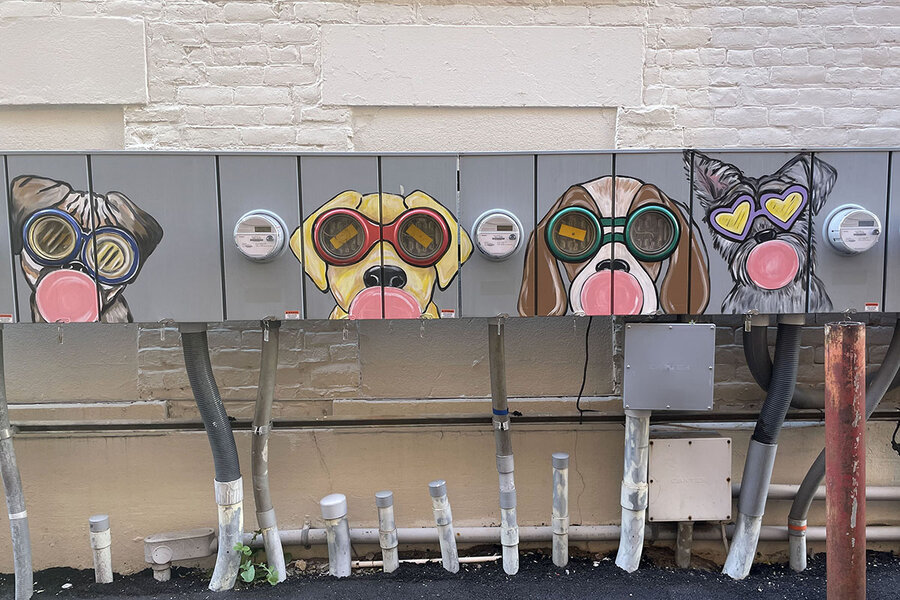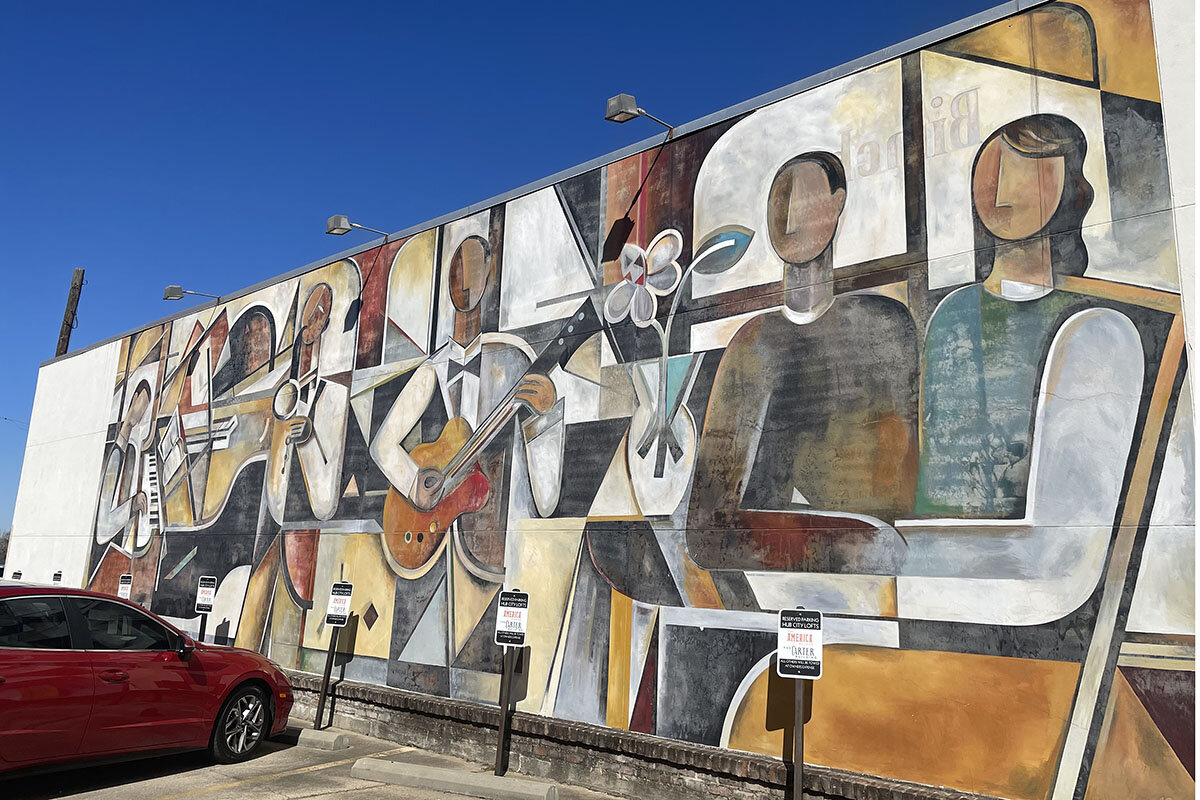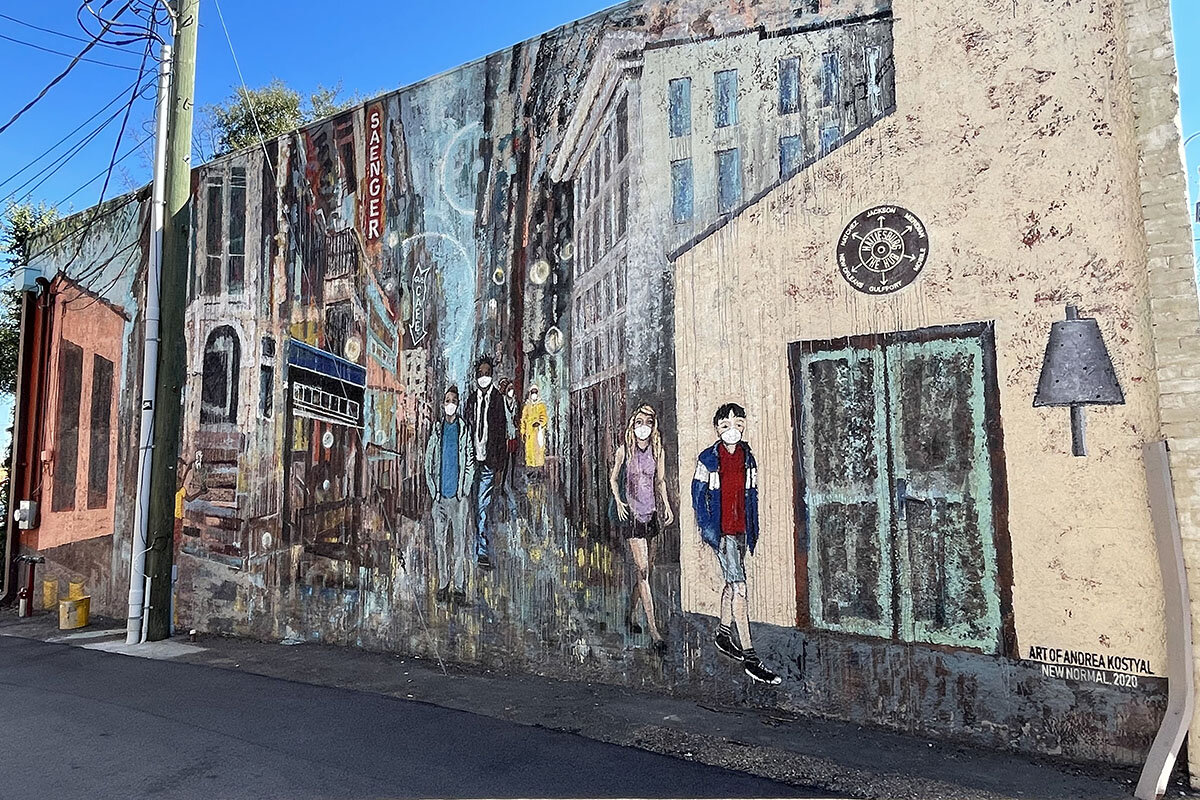In this Mississippi city, public art points a way forward
Loading...
| Hattiesburg, Miss.
Madison Rux lives just outside Hattiesburg, Mississippi, but she finds herself in the city often. Sometimes it’s for work, sometimes for her social life. Sometimes it’s to get a moment to herself to think clearly, alone, while she strolls the city until she runs into one of her favorite works of public art.
It’s of a large, vibrant hummingbird, a painting by Texas artist Avery Orendorf titled “Spread Your Wings.” It reminds Ms. Rux of herself, and of the trials she faced as a teenager. She relocated from Central Texas to Mississippi six years ago, after her adopted parents kicked her out of their home at age 17. She had to reinvent herself and navigate the world on her own.
“Growing up, I was always the person my parents wanted me to be,” Ms. Rux says. “I had to figure out who I was again. It was a journey. I had to spread my wings and fly on my own.”
Why We Wrote This
In seeking to build community spirit and keep young residents from moving to greener urban pastures, where did Hattiesburg, Mississippi, turn? To something as simple as paint on walls – part of rising global appreciation for the importance of public art.
For a small city with a population hovering near 50,000, Hattiesburg is teeming with life, and purposefully, through color. On some corners, bright paintings like the hummingbird spring from sunbeams as if they’re coming to life. On others, the paintings are nods to the city’s culture, such as a mural by Mississippi artist Amy Giust – an abstract rendition of a weekend out on the town. It’s in part an ode to the state’s place in American music history.
Block after block, artwork after artwork, Hattiesburg has declared public art as its theme. There are as many as 46 public art installations like these citywide – including at least 35 murals plus sculptures and other mediums. The public art presence is a defining element for a city that’s better known for its student population divided between the University of Southern Mississippi and William Carey College. With impetus from the Hattiesburg Alliance for Public Art, the city aims to decorate its rustic streets so they inspire those who grace them.
The city’s effort to immerse itself in art earned national recognition earlier this year when Travel & Leisure magazine noted Hattiesburg as one of the world’s top public art destinations, alongside creative capitals like Berlin, Paris, and London. In the U.S., Miami and New York City were the only cities ranked ahead of humble Hattiesburg; Philadelphia was listed one spot below.
But the goal isn’t necessarily about garnering more tourist dollars, says Shawn Harris, a Downtown Hattiesburg Association board member who’s volunteered throughout the city’s beautification project. Rather, it’s about creating a better space for the community.
“That’s the model we follow in Hattiesburg. If you make your residents happy, tourists will come and appreciate those things, but you’re not ostracizing your residents at that cost,” Mr. Harris says. “It’s really about community development and not economic development.”
Art “raises our morale, ... connects us to each other”
In fact, researchers who study people’s response to aesthetics say art affects our outlook and thoughts.
“The arts are somewhat on the fringes” of mainstream psychological study, says Ellen Winner, a professor specializing in art psychology at Boston College. “But they’re coming more into the center now, as people are realizing the importance of art.”
Even momentary encounters with art can be healthy.
As Professor Winner explains, public art can help us feel more connected to our immediate surroundings and to artists. It wakes us up to the world around us. It makes us ask ourselves how another person interprets the same piece of work through their own lens. It makes us wonder.
The process of viewing public art “raises our morale, connects us to the arts, connects us to each other, it makes us think, and it raises our mood,” Dr. Winner says.
That was one key goal at the inception of the Hattiesburg Alliance for Public Art in 2014.
Sculptures and murals began lighting up the city’s downtown streets, beckoning life and excitement for residents. As installations sprouted, city leaders began exploring ways to better allow residents and tourists to explore them. Then came the pandemic.
Like most U.S. cities, Hattiesburg temporarily shut down. Its public art display didn’t. In fact, city leaders decided to lean into commissioning more public art, creating an escape for locals. The creators are about half local, with the other half from other Mississippi artists and those working on the national stage.
The Hattiesburg Alliance for Public Art and Visit Hattiesburg collaborated last year to implement the Hattiesburg Public Art Trail, a socially distanced, outdoor activity. Lately, the city has also begun turning its public utility boxes – those gray metal boxes often seen on city street medians – into public art installations.
It’s about “making things more beautiful,” says Ricardo Moody, a local high school art teacher who has several public installations in Hattiesburg, including several murals and a utility box.
The theme of community is central to his abstract work. Mr. Moody points to a mural he was asked to produce on the side of a local business owner’s building. It’s titled “Wonderful Day” – a splash of warm colors, centered around a quote by civil rights pioneer Maya Angelou: “This is a wonderful day. I’ve never seen this one before.” Several local high school kids came to help Mr. Moody produce it – resulting in a design that incorporated their school colors.
“The plants that I painted there, the leaves, is having to do with growth,” Mr. Moody says in describing his work. And much like Hattiesburg, “as things grow, they mature and thrive.”
Building a city’s future
Over the next five years, Hattiesburg hopes to become “the city of 100 murals.” That’s the directive handed down from Mayor Toby Barker.
It’s an achievable goal, says Kristen Brock, director of programs and promotions at the community advocacy group VisitHBURG.
“Hattiesburg has embraced this public art venture that we are on,” Ms. Brock says, noting how the effort has received support from residents, business owners, and organizations alike. “Then on the flip side, we have seen huge interest from visitors coming to Hattiesburg. We estimated that we had interaction from about 300,000 people last year who were interested in our public art.”
For residents like Mr. Harris of the downtown association, it’s affirming to see Hattiesburg receive national attention.
“It’s so easy to make the national news for something negative,” Mr. Harris says. He describes their effort as “a testament to following a plan and understanding what your community needs.”
Residents and community leaders alike also hope their efforts counter some of Mississippi’s ongoing obstacles such as brain drain, with outmigration that has included a period of the highest rate of millennial exodus in the nation.
“I think public art plays a role in making [talented individuals] realize they can have a future in Hattiesburg,” Ms. Brock says.
It’s the city’s way of building community, she adds.
But for community members like Ms. Rux, the city’s art display is a way of building herself.
On her strolls alone through Hattiesburg, Ms. Rux makes a point to visit the hummingbird mural. She also likes to take the time to stroll a little bit further across town to a painting of a red cardinal. She grew up believing that cardinals were the souls of loved ones who have died.
Ms. Rux likes to think of the cardinal as her late grandmother checking in on her.
“Whenever I don’t see a cardinal for a little while,” Ms. Rux says, “I go over there.”







